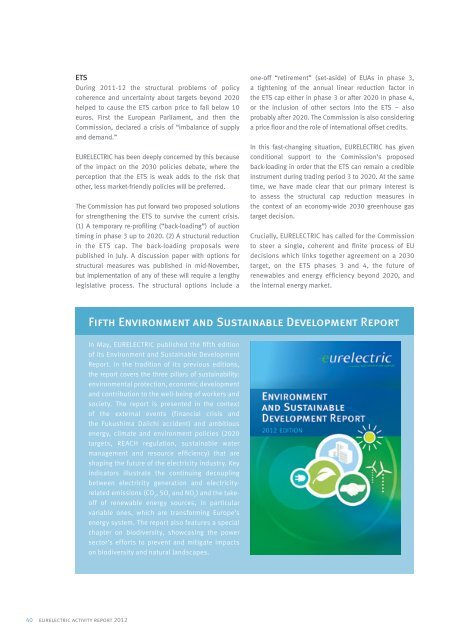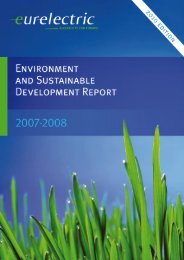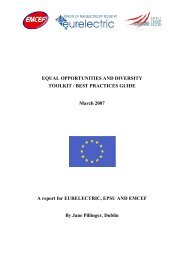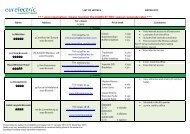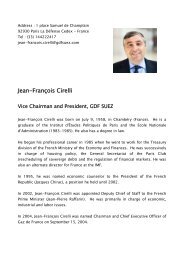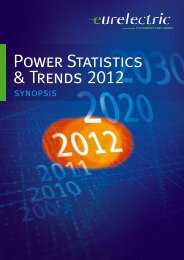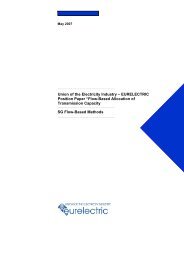Activity Report 2012 - Eurelectric
Activity Report 2012 - Eurelectric
Activity Report 2012 - Eurelectric
You also want an ePaper? Increase the reach of your titles
YUMPU automatically turns print PDFs into web optimized ePapers that Google loves.
ETS<br />
During 2011-12 the structural problems of policy<br />
coherence and uncertainty about targets beyond 2020<br />
helped to cause the ETS carbon price to fall below 10<br />
euros. First the European Parliament, and then the<br />
Commission, declared a crisis of “imbalance of supply<br />
and demand.”<br />
EURELECTRIC has been deeply concerned by this because<br />
of the impact on the 2030 policies debate, where the<br />
perception that the ETS is weak adds to the risk that<br />
other, less market-friendly policies will be preferred.<br />
The Commission has put forward two proposed solutions<br />
for strengthening the ETS to survive the current crisis.<br />
(1) A temporary re-profiling (“back-loading”) of auction<br />
timing in phase 3 up to 2020. (2) A structural reduction<br />
in the ETS cap. The back-loading proposals were<br />
published in July. A discussion paper with options for<br />
structural measures was published in mid-november,<br />
but implementation of any of these will require a lengthy<br />
legislative process. The structural options include a<br />
40 eurelectric activity report <strong>2012</strong><br />
In May, EURELECTRIC published the fifth edition<br />
of its Environment and Sustainable Development<br />
<strong>Report</strong>. In the tradition of its previous editions,<br />
the report covers the three pillars of sustainability:<br />
environmental protection, economic development<br />
and contribution to the well-being of workers and<br />
society. The report is presented in the context<br />
of the external events (financial crisis and<br />
the Fukushima Daiichi accident) and ambitious<br />
energy, climate and environment policies (2020<br />
targets, REACH regulation, sustainable water<br />
management and resource efficiency) that are<br />
shaping the future of the electricity industry. Key<br />
indicators illustrate the continuing decoupling<br />
between electricity generation and electricityrelated<br />
emissions (CO 2 , SO 2 and nO x ) and the takeoff<br />
of renewable energy sources, in particular<br />
variable ones, which are transforming Europe’s<br />
energy system. The report also features a special<br />
chapter on biodiversity, showcasing the power<br />
sector’s efforts to prevent and mitigate impacts<br />
on biodiversity and natural landscapes.<br />
one-off “retirement” (set-aside) of EUAs in phase 3,<br />
a tightening of the annual linear reduction factor in<br />
the ETS cap either in phase 3 or after 2020 in phase 4,<br />
or the inclusion of other sectors into the ETS – also<br />
probably after 2020. The Commission is also considering<br />
a price floor and the role of international offset credits.<br />
In this fast-changing situation, EURELECTRIC has given<br />
conditional support to the Commission’s proposed<br />
back-loading in order that the ETS can remain a credible<br />
instrument during trading period 3 to 2020. At the same<br />
time, we have made clear that our primary interest is<br />
to assess the structural cap reduction measures in<br />
the context of an economy-wide 2030 greenhouse gas<br />
target decision.<br />
Crucially, EURELECTRIC has called for the Commission<br />
to steer a single, coherent and finite process of EU<br />
decisions which links together agreement on a 2030<br />
target, on the ETS phases 3 and 4, the future of<br />
renewables and energy efficiency beyond 2020, and<br />
the internal energy market.<br />
Fifth Environment and Sustainable Development <strong>Report</strong>


